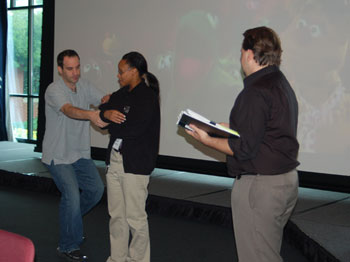 Interpretation: Any information that is presented to the visitor at a museum, in whatever form or medium, is interpretation. This includes signs, labels, text panels and videos, as well as live interpretation.
Live interpretation: any live, real-time interaction between staff and visitors at a cultural institution. This includes many living history-type activities, ranging from non-costumed demonstrations of historical craft, to storytelling and costumed first- and third-person interpretation. Activities such as guided tours, education workshops, theatre performances and demonstrations are also considered live interpretation.
First-person interpretation: involves an interpreter assuming a particular role as a “character.” Often the interpretation is historically based and involves wearing a period costume. Some sites or museums adhere very strictly to this technique, with their staff never “breaking character.”
Third person interpretation: involves an interpreter interacting with the public using their own “voice,” and from their own point of view, not that of a character. The third-person interpreter may or may not be costumed.
Living history: a very broad term used to describe recreated historical environments and/or the people who work there. Interpreters engaged in living history may be in character, in costume, or both. (See “first-person interpretation” and “third-person interpretation,” above.)
Re-enactment: a detailed recreation of a historical event, such as a battle, where action, costume and combat provide visual impact from a distance.
First/Third person: This kind of interpretation allows an interpreter to step in and out of “character” according to the situation and the needs of the visitors involved.
Role-play: Interpretation wherein the audience–as well as the interpreter–are invited to assume a role or roles. Role play includes everything from asking visitors to engage in an activity or discussion with a character, to the audience preparing in advance and wearing appropriate costumes.
Storytelling: Storytelling is one of the oldest forms of communication, used by all cultures to pass on knowledge and ways of knowing. Storytelling is particularly adaptable as one may include modern stories as well as ancient; read from a book or memorize the material; use docents or professional storytellers; and utilize musical accompaniment, puppets, sign language, audience participation etc. Or not.
Creative Drama/Creative Dramatics: Interactions that utilize elements of drama such as movement, imagination, role-playing, improvisation etc. These interactions can complement performances and interpretation but also can occur independently of a specific context. When CD occurs independently, it is usually in the form of exploratory theater warm up games or sensory exercises designed to familiarize visitors with drama for drama’s sake.
|

